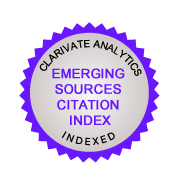Phase formation of boron carbide powder synthesized from glutinous rice flour
Keywords:
Boric acid, Glutinous rice flour, Phase formation, Boron carbideAbstract
Boron carbide is an attractive material because of its very high hardness and low density. A number of synthesis processes to produce various forms of boron carbide powders have been reported. In this study, the feasibility of boron carbide synthesis using an inexpensive carbon source, glutinous rice flour, was investigated. Boric acid and glutinous rice flour with the molar ratios, ranging from 2:1 to 4:1, were homogeneously mixed with deionized water at 80°C. The mixtures were dried and pyrolyzed at 700°C for 2 h in air. The phase present and the carbon: boron oxide molar ratio of the pyrolyzed precursor were determined in order to control boron and carbon contents for the synthesis process. The precursor was synthesized under an Ar flow in a tube furnace at 1350°C - 1450°C for 1, 3 and 5 h. Phase analysis, chemical bonding and morphology of the synthesized powder were identified by X-ray diffraction, Fourier-transform infrared spectroscopy and scanning electron microscopy, respectively. It was found that formation of B4C as a major phase was observed at 1450°C, though unreacted B2O3 and carbon still persisted in the final product. In addition, the composition with large number of hydroxyl group showed the B4C phase formation at lower temperature and shorter soaking time.Downloads
References
M. H. Al-Taie, F. A. Chyad, and H. AlaaJaber, “An experimental investigation of B4C preparation from boric acid–polymeric gel precursors at low temperature,” Iraqi journal of mechanical and material engineering, vol. 14, pp. 408-422, 2014.
C.-H. Jung, M.-J. Lee, and C.-J. Kim, “Preparation of carbon-free B4C powder from B2O3 oxide by carbothermal reduction process,” Materials letters, vol. 58, pp. 609-614, 2004.
F. Thevenot, “Boron carbide-a comprehensive review,” Journal of the European Ceramic society, vol. 6, pp. 205-225, 1990.
A. Suri, C. Subramanian, J. Sonber, and T. C. Murthy, “Synthesis and consolidation of boron carbide: a review,” International Materials Reviews, vol. 55, pp. 4-40, 2010.
A. Sinha, T. Mahata, and B. Sharma, “Carbothermal route for preparation of boron carbide powder from boric acid–citric acid gel precursor,” Journal of Nuclear Materials, vol. 301, pp. 165-169, 2002.
M. Kakiage, N. Tahara, I. Yanase, and H. Kobayashi, “Low-temperature synthesis of boron carbide powder from condensed boric acid–glycerin product,” Materials letters, vol. 65, pp. 1839-1841, 2011.
N. Shawgi, S. Li, and S. Wang, “A Novel method of synthesis of high purity nano plated boron carbide powder by a solid-state reaction of poly (vinyl alcohol) and boric acid,” Ceramics International, vol. 43, pp. 10554-10558, 2017.
T. R. Pilladi, K. Ananthasivan, S. Anthonysamy, and V. Ganesan, “Synthesis of nanocrystalline boron carbide from boric acid–sucrose gel precursor,” Journal of Materials Science, vol. 47, pp. 1710-1718, 2012.
S. K. Vijay, R. Krishnaprabhu, V. Chandramouli, and S. Anthonysamy, “Synthesis of nanocrystalline boron carbide by sucrose precursor methodoptimization of process conditions,” Ceramics International, vol. 44, pp. 4676-4684, 2018.
M. Maqbool, G. Zahid, E. Ahmad, Z. Asghar, T. Subhani, M. Shahzad, and I. Kaleem, “Effect of saccharides as carbon source on the synthesis and morphology of B4C fine particles from carbothermal synthesis precursors,” Materials Express, vol. 5, pp. 390-400, 2015.
G. Zahid, E. Ahmad, M. Maqbool, T. Subhani, W. A. Syed, and S. Z. Hussain, “Effect of cellulose-derived structural homogeneity of precursor on the synthesis and morphology of boron carbide,” Journal of Inorganic and Organometallic Polymers and Materials, vol. 25, pp. 995-999, 2015.
X. Chen, S. Dong, Y. Kan, H. Zhou, J. Hu, and Y. Ding, “Effect of glycerine addition on the synthesis of boron carbide from condensed boric acid–polyvinyl alcohol precursor,” RSC Advances, vol. 6, pp. 9338-9343, 2016.
N. Tahara, M. Kakiage, I. Yanase, and H. Kobayashi, “Effect of addition of tartaric acid on synthesis of boron carbide powder from condensed boric acid–glycerin product,” Journal of Alloys and Compounds, vol. 573, pp. 58-64, 2013.
B. Wade, N. Venkatasubramanian, P. Desai, A. Abhiraman, E. Ashby, and L. Gelbaum, “Synthesis and characterization of processable polyborate precursors,” Journal of Sol-Gel Science and Technology, vol. 5, pp. 15-25, 1995.
Y. M. Ahmed, S. M. El-Sheikh, E. M. Ewais, A. A. Abd-Allah, and S. A. Sayed, “Controlling the Morphology and Oxidation Resistance of Boron Carbide Synthesized Via Carbothermic Reduction Reaction,” Journal of Materials Engineering and Performance, vol. 26, pp. 1444-1454, 2017.
R. Kizil, J. Irudayaraj and K. Seetharaman, “Characterization of irradiated starches by using FT-Raman and FTIR spectroscopy,” Journal of agricultural and food chemistry, vol. 50, pp. 3912-3918, 2002.
V. Pimpan, R. Sirisook, S. Rungsumpunkul, and S. Cheunchon, “A Preliminary Study on the Preparation of Environmentally Friendly Materials from Modified Glutinous Starch,” Journal of Metals, Materials and Minerals, vol. 12, pp. 59-65, 2003.
S. Mondal and A. K. Banthia, “Low-temperature synthetic route for boron carbide,” Journal of the European Ceramic society, vol. 25, pp. 287-291, 2005.
P. M. Barros, I. V. P. Yoshida, and M. A. Schiavon, “Boron-containing poly (vinyl alcohol) as a ceramic precursor,” Journal of noncrystalline solids, vol. 352, pp. 3444-3450, 2006.
M. Kakiage, N. Tahara, R. Watanabe, I. Yanase, and H. Kobayashi, “Microstructure in precursor formed by controlling composition of condensed boric acid-poly (vinyl alcohol) product for low-temperature synthesis of boron carbide powder,” Journal of the Ceramic Society of Japan, vol. 121, pp. 40-44, 2013.
Downloads
Published
How to Cite
Issue
Section
License
Copyright (c) 2019 Journal of Metals, Materials and Minerals

This work is licensed under a Creative Commons Attribution-NonCommercial-NoDerivatives 4.0 International License.
Authors who publish in this journal agree to the following terms:
- Authors retain copyright and grant the journal right of first publication with the work simultaneously licensed under a Creative Commons Attribution License that allows others to share the work with an acknowledgment of the work's authorship and initial publication in this journal.
- Authors are able to enter into separate, additional contractual arrangements for the non-exclusive distribution of the journal's published version of the work (e.g., post it to an institutional repository or publish it in a book), with an acknowledgment of its initial publication in this journal.








